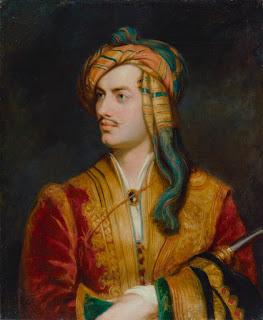"The Giaour" (A Poem Excerpt)
Before the Romantic Movement of the early nineteenth century, European representations of the vampire commonly portrayed the mythological being as a beastly predator whose insatiable thirst for human blood was matched by its hideous appearance.[1] In 1813, Lord Byron published his epic poem The Giaour chronicling the tribulations of the giaour, who is punished for murdering the abusive Hassan in the name of justice. Part of his punishment is to become a vampire and live forever feasting on the blood of his heirs. Although a minor element within the entirety of the work, the concept of the tormented undead, jilted in life and love, set a new standard for images of the vampire which consumed Romanticist literature and the Parisian Théâtre des Vampires.[2] Presented below is the passage from The Giaour (lines 757-768) which details the character's fate and establishes, as scholars such as David Skal attest, the notion of the brooding vampire.
But first, on earth as Vampyre sent,
Thy corse shall from its tomb be rent;
Then ghastly haunt thy native place,
And suck the blood of all thy race;
There from thy daughter, sister, wife,
At midnight drain the stream of life;
Yet loathe the banquet, which perforce
Must feed thy livid, living corse,
Thy victims, ere they yet expire,
Shall know the demon for their sire;
As cursing thee, thou cursing them,
Thy flowers are withered on the stem.[3]
Works Referenced
Bryon, George Gordon. The Giaour, A Fragment of a Turkish Tale. 1813. London: Thomas Davidson, 1814.
Skal, David. Hollywood Gothic: The Tangled Web of Dracula from Novel to Stage to Screen. New York: W.W. Norton and Company, 1990.
____________________
[1] Skal, 13.
[2] Skal, 13.
[3] Byron, 37-38.

No comments:
Post a Comment